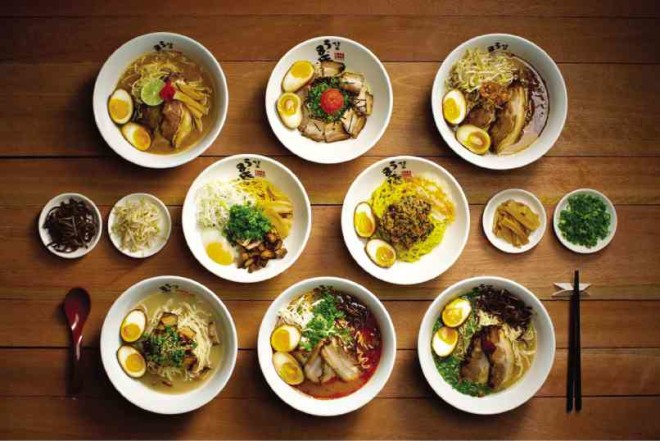
IN SINGAPORE I always try to have my fill of hawker food, although I usually switch to pure comfort in a bowl of ramen especially in Uma Uma at the Forum Mall.
The good news is that Uma Uma Ramen has opened in Manila at the Marina Way, Mall of Asia complex.
Its signature ramen is presented Hakata-style—the broth thick, rich and immensely flavorful, the noodles thin and straight with a nice chew. The soup is garnished with spring onions, thin strips of wood-ear mushroom, egg, and slices of chasu (pork belly) that make the hearty bowl more scrumptious.
The broth is pork-based. Each pot of soup stock requires 40 kg of bones boiled over a minimum of 12 hours. This long cooking process is crucial in achieving the concentration and creaminess required to meet the standards of Uma Uma’s signature broth, which is 100-percent MSG-free.
Uma Uma Ramen uses traditional noodles from an age-old family recipe formulated by Takeomi Teshima, who opened his ramen house, Wu Maru, in 1953 in Fukuoka, Japan.
When his son Masahiko took over in 1994, he renamed the restaurant Uma Uma Ramen, from the Japanese word for “tasty.”
While Uma Uma is a traditional ramen house, it also serves creative dishes—for instance, the Alba White Truffle Ramen and Yu Sheng Ramen, a spin-off from the traditional Chinese New Year salad.
I look forward to such unique fare in the future.
Aside from Uma Uma Ramen, I have a penchant for mazesoba, a dry ramen with bamboo shoots, spring onions, leeks and tamago. It is seasoned to perfection—a tinge of tartness, a dash of saltiness, spiked with hints of pepper, and a light, sweet finish. The runny egg yolk adds a delightful creaminess to the dish.
The trick to fully appreciating mazesoba is to mix it well so that all the flavors blend. The sapporo-men, a thicker noodle variety, is able to hold more of the sauce.
Transformation
Uma Uma is one of the few restaurants outside Fukuoka that serve bite-size gyoza.
The Hakata/Fukuoka region’s gyozas are mostly the “one bite” type, considered otsumami, or snack eaten on the go or with a few drinks.
After 4 p.m. Uma Uma transforms into an izakaya, a Japanese gastropub with a beautiful view of Manila Bay. It takes inspiration from the Horse’s Mouth Singapore, a bar owned and operated by the same group that runs Uma Uma.
Johan Foong, who is responsible for the bar operations of the Horse’s Mouth, is an advocate of using fresh produce and homemade ingredients in beverages. Uma Uma’s cocktails are done the Horse’s Mouth way, fusing traditional and Japanese mixing techniques.
I have sampled the Fluffy Duck (dark rum, lemon juice, sugar, egg yolk and nutmeg), an easy, refreshing drink.
But my personal favorite is the Old Fashioned (bourbon, oolong tea reduction and angostura bitters) which has a complex yet pleasant finish.
To be paired with the signature drinks are the mini yakitori sticks. Uma Uma Fukuoka and Singapore are known for tori-kawa yakitori (chicken skin), which will soon be launched in the Manila branch.
Over the next few months, expect 15-20 varieties of yakitori on the menu daily after 4 p.m. Uma Uma will also introduce several kinds of tasty kushiage (deep-fried meat and vegetables in skewers).
Mindanao culinary event
The Davao chapter of LTB Philippines Chefs Association has launched the Davao Culinary Cup 2016 to be held today till June 18 at SM Lanang Premier Atrium.
The World Food Expo Mindanao will be held simultaneously.
Contact 0922-8630932, 0939-8065383; visit davaoculinarycup.wix.com/davao or facebook.com/DavaoCulinaryCup.